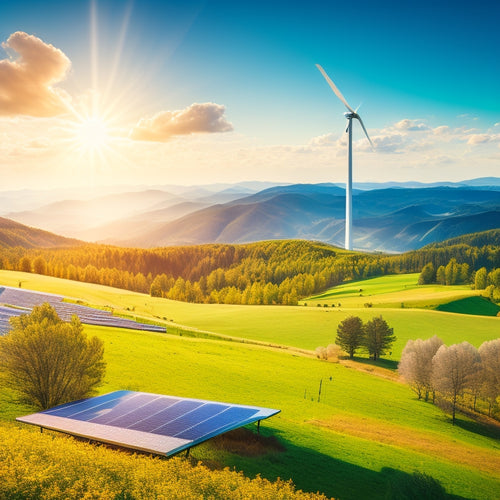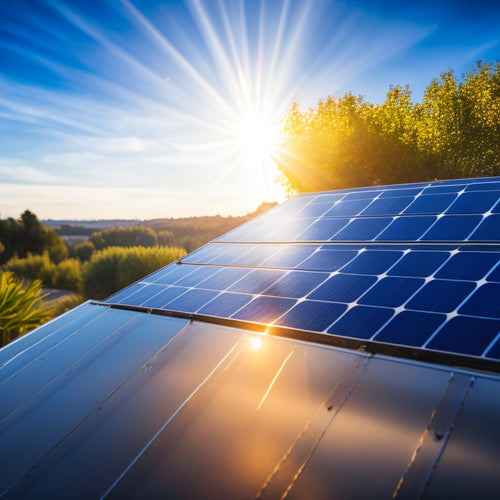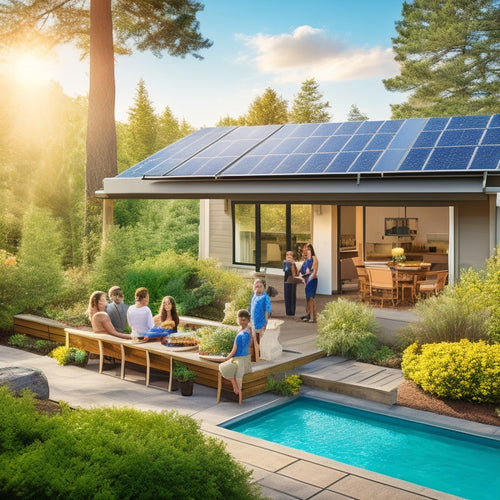
Boost Your Energy Efficiency Today
Share
You can enhance your energy efficiency today by conducting a thorough home audit to identify areas of waste, priority-adjusting solutions like smart thermostats and insulation upgrades, and implementing changes to reduce your utility bills and environmental footprint. Start by evaluating insulation gaps, calculating daily energy consumption, and spotting waste patterns in your energy report. Then, focus on critical areas, invest in energy-saving solutions like solar panels and LED lighting, and track your performance to guarantee your goals are met. By doing so, you'll be taking the first steps towards a more energy-efficient you, and there's more to investigate to maximize your savings.
Overview
- Conduct a thorough home energy audit to identify areas of inefficiency and prioritize improvements.
- Replace incandescent bulbs with LED bulbs and upgrade to ENERGY STAR appliances to reduce energy consumption.
- Implement energy-saving solutions like solar panels, smart thermostats, and insulation upgrades to cut energy costs.
- Monitor and adjust energy performance using advanced data analytics and energy monitoring tools like smart meters.
- Focus on critical areas identified in the audit and track progress to ensure energy efficiency goals are met.
Increase Home Energy Efficiency Now
Your wallet and the environment will thank you for making your home more energy efficient. By taking simple steps, you can reduce your energy consumption and save money on your utility bills.
Start by evaluating your energy needs through a total consumption calculation and energy audit to identify high usage areas and potential reductions. Installing smart thermostats, which can learn your schedule and preferences to optimize heating and cooling, is another great way to start.
Replace traditional incandescent bulbs with LED bulbs, which use considerably less energy. Upgrade to energy-efficient appliances, such as those with the ENERGY STAR label, which meet strict energy efficiency guidelines.
These changes may seem small, but they can make a notable impact on your energy consumption. By taking control of your energy usage, you'll not only reduce your environmental footprint but also enjoy the freedom that comes with saving money.
Conduct a Thorough Home Audit
A thorough home audit is the vital first step in identifying areas of energy inefficiency, allowing you to pinpoint opportunities for improvement.
You'll want to assess your home's insulation, paying attention to gaps and cracks around doors, windows, and electrical outlets. Check your attic, walls, and floors for adequate insulation, as heat can escape through these areas.
Additionally, it's important to calculate total daily energy consumption and create an energy profile to understand your energy needs and consumption patterns.
Conducting an energy audit will help you identify areas where energy is being wasted. You can do this yourself or hire a professional to perform a more extensive assessment.
The audit will provide you with a detailed report outlining areas of inefficiency and recommending improvements. By understanding where your home is losing energy, you can take the necessary steps to optimize your energy usage and start saving money.
Identify Energy Wasting Areas
With a thorough home audit in hand, you're now equipped to pinpoint areas where energy is being squandered.
Review your draft energy report to identify patterns of waste. Assess appliance usage to determine which devices are guzzling the most power.
Check for air leaks, insulation gaps, and inefficient lighting fixtures that let energy escape. By calculating your daily energy needs daily energy consumption, you can prioritize energy loads into essential, semi-essential, and non-essential for ideal resource allocation.
You may be surprised to find that seemingly minor issues, like a faulty thermostat or outdated refrigerator, are significant contributors to your energy bill.
Implement Energy Saving Solutions
Implementing energy-saving solutions demands a strategic approach, starting with the most critical areas identified in your home audit. You've pinpointed the energy-wasting culprits, and now it's time to take action.
| Solution | Energy Savings | Cost Savings |
|---|---|---|
| Solar Panels | 50-70% | $400-$700/year |
| Smart Thermostats | 10-20% | $100-$200/year |
| Insulation Upgrades | 30-40% | $300-$500/year |
| Energy Efficient Appliances | 20-30% | $200-$300/year |
| LED Lighting | 50-60% | $100-$200/year |
Monitor and Adjust Performance
Your energy-efficient makeover is underway, and now it's vital to keep a close eye on its performance. Performance tracking is fundamental to understanding how your energy-saving solutions are impacting your energy consumption.
By monitoring your energy usage, you can identify areas that require adjustments to optimize performance. Implementing advanced data analytics platforms Real-Time Performance Monitoring Systems can provide granular tracking and pinpoint inefficiencies for data-driven decisions.
Invest in energy monitoring tools, such as smart meters or energy auditing software, to collect data on your energy consumption. Analyze this data to pinpoint opportunities for improvement and make adjustments accordingly.
Regularly review your performance to verify you're meeting your energy efficiency goals. By staying on top of your performance, you'll be able to make data-driven decisions that maximize your energy savings and pave the way to a more sustainable future.
Frequently Asked Questions
How Does Energy Efficiency Impact the Environment?
You reduce your carbon footprint by adopting energy-efficient practices, which in turn supports sustainable living, conserving natural resources, and mitigating climate change, ultimately granting you the freedom to live in harmony with the environment.
Can Energy-Efficient Upgrades Increase My Home's Value?
Like a gem polished to perfection, energy-efficient upgrades can markedly increase your home's value, as a home appraisal will reveal, enhancing resale value and giving you the freedom to sell or refinance with confidence.
Are Energy-Efficient Appliances Worth the Extra Cost?
When you're shopping for appliances, you'll likely notice energy-efficient options come with a higher initial investment, but don't let that deter you - they'll provide long-term savings, and you'll enjoy the freedom from hefty utility bills and a clear conscience.
Do Energy-Efficient Windows Really Make a Difference?
You're wondering if energy-efficient windows are just a fancy sales pitch, but trust us, they're a revolutionary innovation! With high-quality window insulation, you'll slash your energy bills by up to 40%, reaping significant cost savings that'll give you the freedom to live life on your terms!
Can I DIY Energy-Efficient Home Improvements?
You can DIY energy-efficient home improvements, like adding insulation, weather stripping, and LED lighting, but consider hiring a pro for complex tasks like solar paneling, energy audits, and smart thermostat installations to guarantee the best results and safety.
Ready to Buy
As you commence this energy-efficient expedition, remember that every small step counts, just like the proverbial "drop of water that makes a mighty ocean." By conducting a thorough home audit, identifying energy-wasting areas, and implementing solutions, you're not only reducing your carbon footprint but also saving money on your utility bills. Monitor and adjust your performance regularly to guarantee peak results. With persistence and dedication, your home will become a guiding light of energy efficiency, shining brightly like a lighthouse on a sustainable path.
Related Posts
-

Renewable Energy Solutions to Reduce Your Carbon Footprint
To reduce your carbon footprint, adopting renewable energy solutions is key. Using solar panels or wind turbines can ...
-

How Efficient Are Thin Film Solar Cells
Thin film solar cells provide an innovative approach to energy generation, boasting efficiency rates generally betwee...
-

Top-Rated Home Solar Power Kits for Achieving Energy Independence
Top-rated home solar power kits enable you to achieve energy independence by greatly cutting your energy costs. You c...


